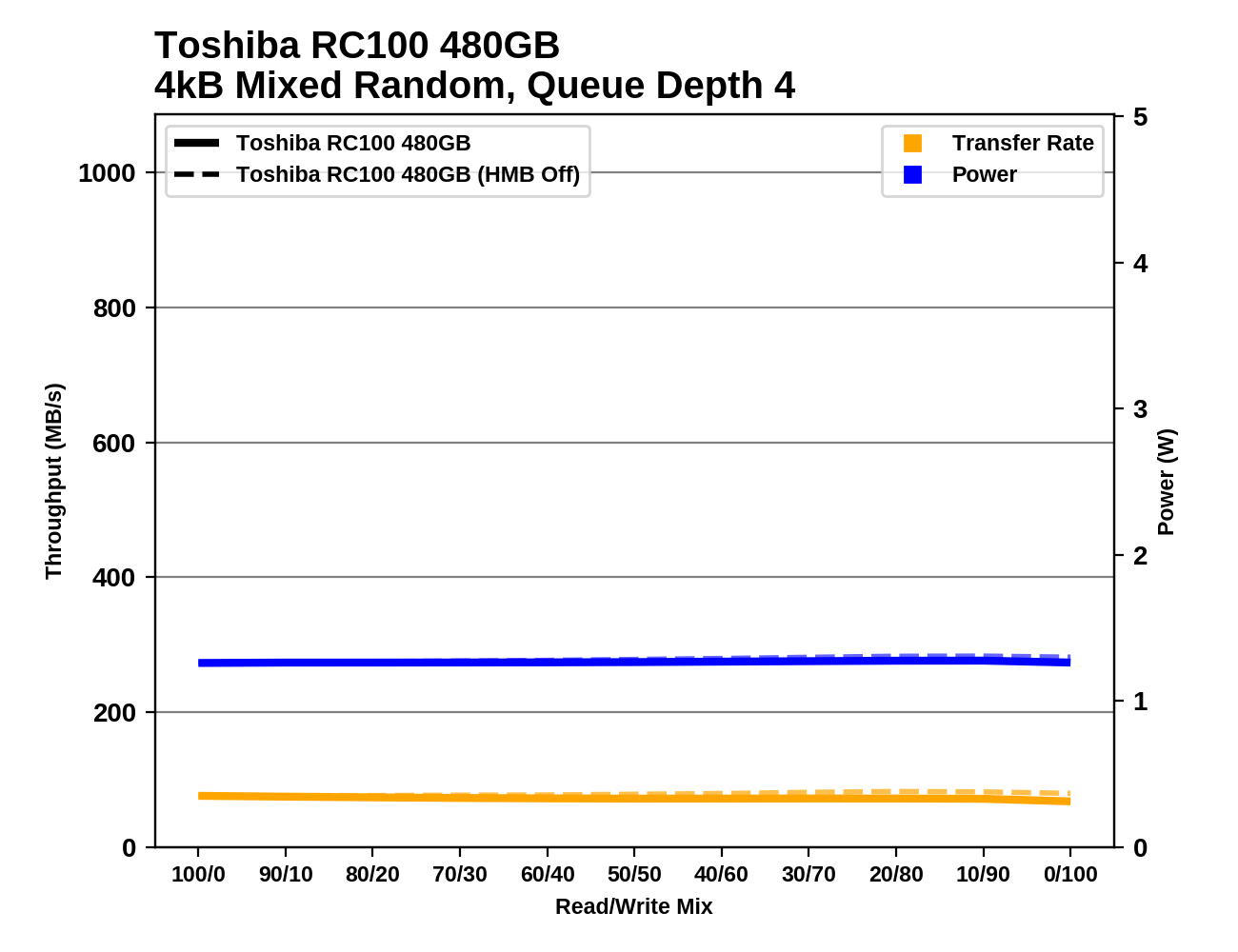The Toshiba RC100 SSD Review: Tiny Drive In A Big Market
by Billy Tallis on June 14, 2018 9:00 AM ESTMixed Random Performance
Our test of mixed random reads and writes covers mixes varying from pure reads to pure writes at 10% increments. Each mix is tested for up to 1 minute or 32GB of data transferred. The test is conducted with a queue depth of 4, and is limited to a 64GB span of the drive. In between each mix, the drive is given idle time of up to one minute so that the overall duty cycle is 50%.

Mixed workloads are often the toughest for DRAMless SSDs, and with this mixed random I/O test covering 64GB of the drive, the Toshiba RC100's Host Memory Buffer is of little use. The RC100 is substantially slower than other NVMe drives on this test.
 |
|||||||||
| Power Efficiency in MB/s/W | Average Power in W | ||||||||
Power efficiency from the RC100 during the mixed random I/O test is also poor, but it's not a significant outlier compared from the competition. Total power consumption is half a Watt lower than any of the other NVMe drives.
 |
|||||||||
The performance and power consumption of the Toshiba RC100 are remarkably constant across the varying workload of this test. There's no sign of improved performance as the fraction of writes increases, which gives most SSDs the opportunity to perform more write combining.
Mixed Sequential Performance
Our test of mixed sequential reads and writes differs from the mixed random I/O test by performing 128kB sequential accesses rather than 4kB accesses at random locations, and the sequential test is conducted at queue depth 1. The range of mixes tested is the same, and the timing and limits on data transfers are also the same as above.

On the mixed sequential I/O test, the Toshiba RC100 is a decent performer with an average that exceeds what any SATA SSD is capable of. HMB is a bit of help here because the sequential access pattern is very cache-friendly even though the test spans a wider range of data than the cache can track.
 |
|||||||||
| Power Efficiency in MB/s/W | Average Power in W | ||||||||
The Toshiba RC100's power efficiency on the mixed sequential I/O test is great with or without HMB. The RC100 is clearly much slower than the high-end drives, but its power consumption is reduced proportionally.
 |
|||||||||
The performance and power consumption of the Toshiba RC100 are not quite as flat on the mixed sequential test as for the mixed random I/O test. The RC100 gets a bit faster as the workload shifts toward writes, and HMB becomes more beneficial with increasing write volume.










62 Comments
View All Comments
MadAd - Saturday, June 23, 2018 - link
+1Anyone can review a flagship release, this is real tech reporting.
Calin - Thursday, June 14, 2018 - link
Yes, more people care about the low-mid end of the market than about the very high end - the M.2 2242 has multiple advantages (compact, doesn't need a 2.5 or 3.5 inch case location, doesn't need power cable, low power. Plenty of people will pay more for that, if the performance is equivalent (just as plenty of people pay more for pretty lights when the performance is equivalent, or pay more for a quiter component, or ...).So, while I'm not interested in M2 drives, thank you for the article :)
gnufied - Thursday, June 14, 2018 - link
Actually I have been looking for a decent 2242 SSD since forever. My thinkpad T450s has a 2242 slot and we have very little options.Having said all this, I dunno if this is comptaible with thinkpad's 2242 slot.
timecop1818 - Thursday, June 14, 2018 - link
most likely not, as that slot is probably for USB-based LTE modem or similar device. M.2 spec does provide for USB connectivity on A, B and E keyed cards/sockets.gnufied - Thursday, June 14, 2018 - link
The 2242 slot defenitely can be used for M.2 SSDs. I am currently using https://www.amazon.com/gp/product/B012ASBZEO/ref=o... SSD with my thinkpad and it works.Reading through R100 review does not fill me with joy though. This NVMe disk does not even look better than M500.. :(
Targon - Thursday, June 14, 2018 - link
M.2 has different flavors, and depending on the slot and device you plug into it, may use a SATA connection rather than NVMe with the dedicated PCI Express lanes. The 2242 is a measure of width and length, NOT the interface. An obvious way to tell is that if you have two notches on the connector, you are not looking at a NVMe connection, while the single notch will support the PCI Express lanes. At least, that is typically what is going on. With only two PCI Express lanes, without investigating, I suppose the two notches might still give you some NVMe, but I wouldn't be sure about that.Kwarkon - Friday, June 15, 2018 - link
There are NVME drives with two notches (M+B), but this keying is limited to only 2 PCIe lines.Jorgp2 - Thursday, June 14, 2018 - link
I already ordered one, I'll try to send you a PM if it worksgnufied - Thursday, June 14, 2018 - link
Nice. thank you. also do a crystal mark or something while you are at it. :-)close - Thursday, June 14, 2018 - link
Because it's less than half the price so it has a better chance of ending up in a "regular machine" than the 970 Pro. Reviews for halo products are great but what do you think most people will have a $350 SSD or a $150 one?